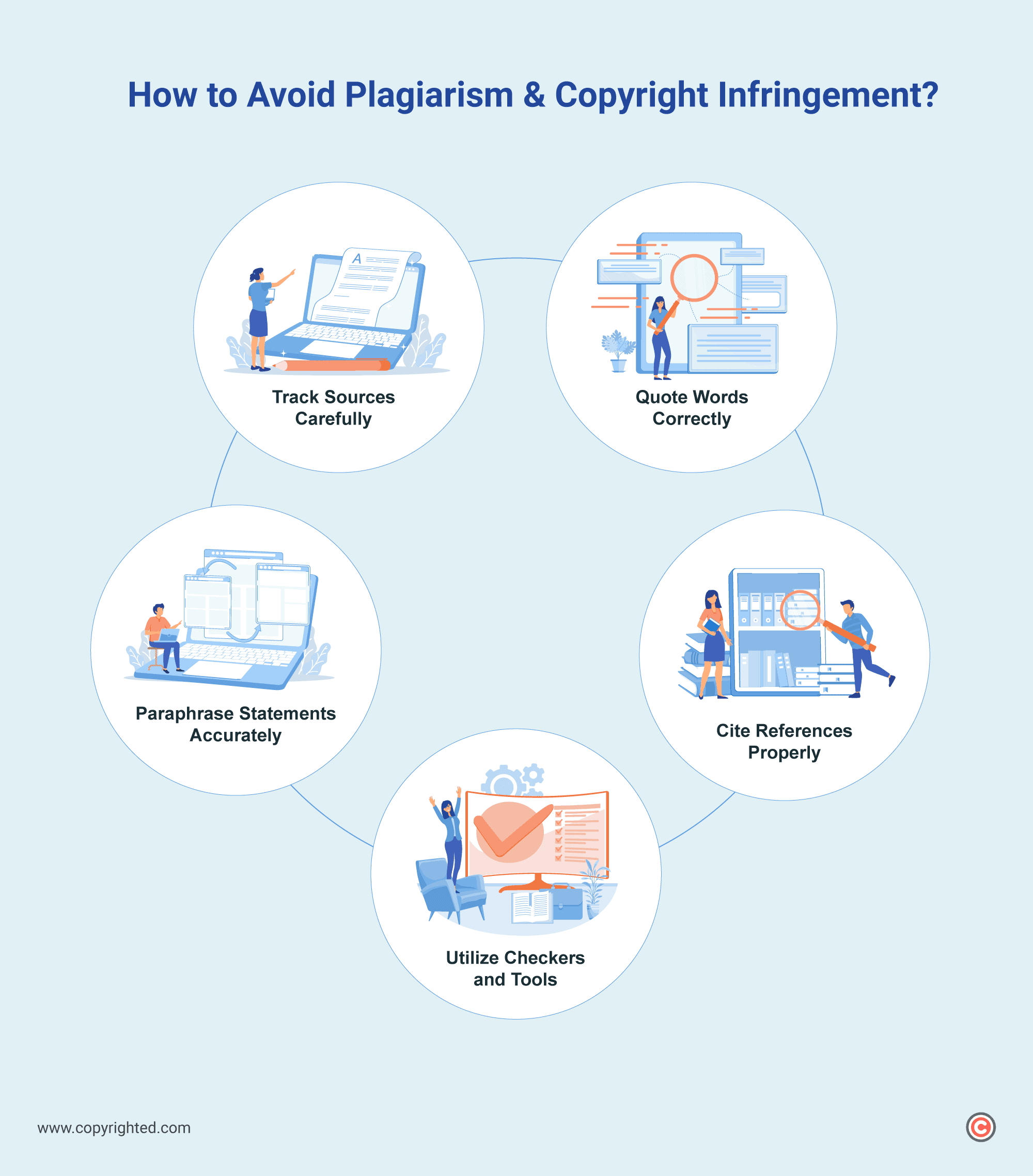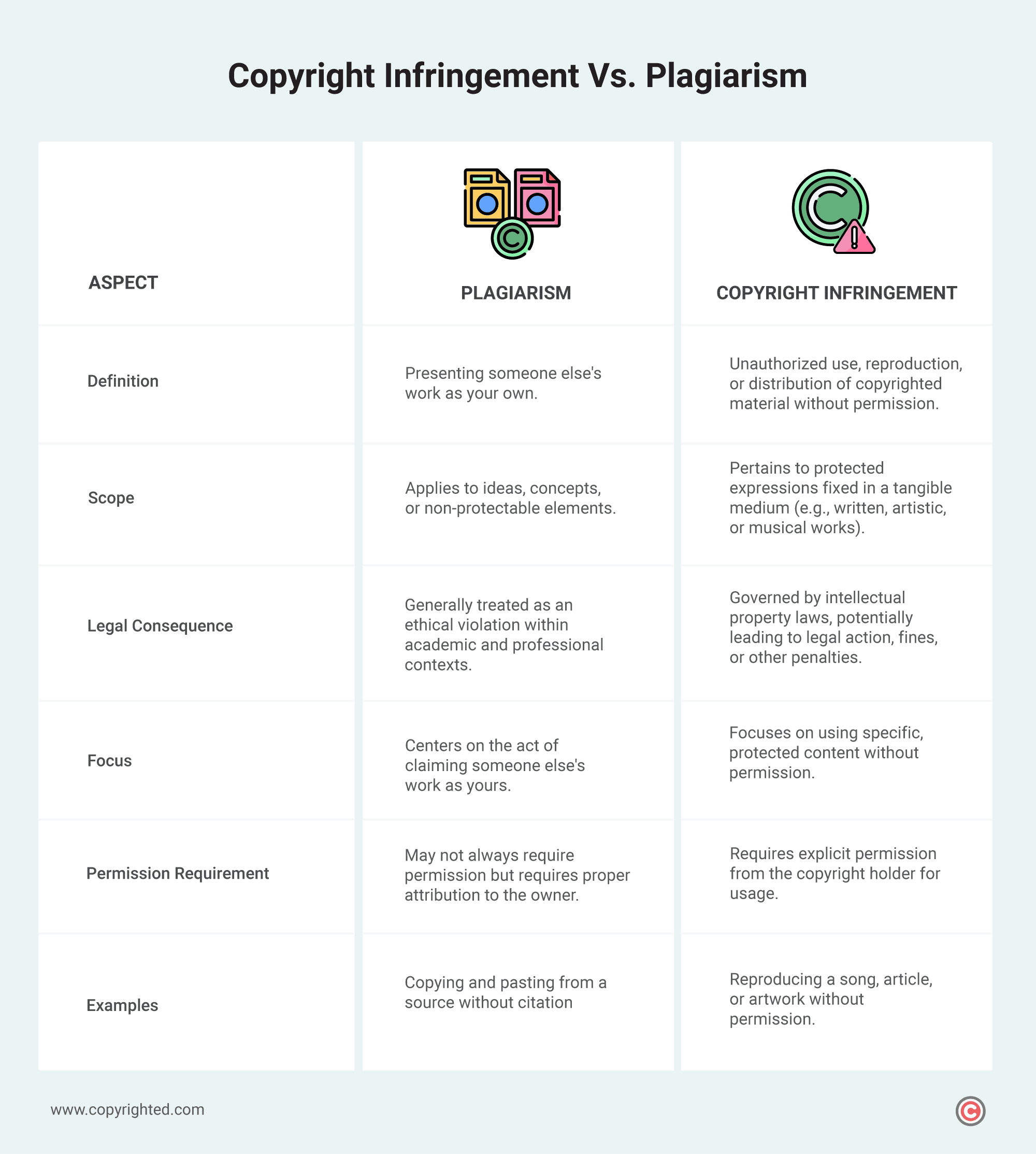The ethical boundaries related to plagiarism and copyright infringement extend beyond academic considerations; they carry significant legal and professional implications. These consequences should not be taken lightly, as they have the potential to influence the course of your professional and creative journey.
In this article, we’ll explore five simple steps to guide you in avoiding both plagiarism and copyright infringement, while emphasizing their importance and legal repercussions.
- Plagiarism involves presenting someone else’s work, ideas, or expressions as your own without proper acknowledgment.
- Plagiarism may not always require permission but demands proper attribution, while copyright infringement mandates explicit permission for usage.
- You can avoid plagiarism and copyright infringement by tracking sources carefully, quoting words accurately, paraphrasing effectively, and citing references consistently.
Table of Contents
How to Avoid Plagiarism and Copyright Infringement?

Dealing with copyright infringement and plagiarism is not a simple matter; it can have lasting impacts on your professional and creative pursuits, affecting your reputation and even leading to legal consequences.
To effectively avoid that, let’s delve into five easy strategies to handle both with simplicity. These steps aren’t just guidelines; they form the basis for creating content that respects intellectual property boundaries.
And, keep in mind, using copyrighted materials correctly isn’t just a legal must-do; it’s a commitment to building a community where creativity flourishes ethically.
1. Track Sources Carefully
To protect your creative journey, make sure to use proper source management practices. Here’s how to make your source management strategy detailed yet simple:
- Note Down Key Information: Start by recording essential details like the author’s name, the publication date, and the title of the source.
- Keep URLs Handy: Save the web addresses (URLs) of online sources. Just like marking spots on a map, having URLs ensures you can revisit the exact locations of your information sources.
- Use a Consistent Format: Develop a system for organizing your sources. Whether it’s alphabetical, chronological, or categorized by topic, consistency is key.
Now, let’s talk about the role of source management in preventing plagiarism and infringement issues.
Proper source management shields you from unintentionally using someone else’s work without proper credit.
By keeping clear records of your sources, you build a strong defense against accusations of plagiarism and copyright infringement. This is particularly helpful in reducing the risk of accidental unintentional plagiarism, which often arises from overlooked or poorly documented references.
2. Quote Words Correctly
Quoting is not just about reproducing words; it’s about honoring the author’s original work. When employing direct quotes, adhere to these simple best practices:
- Exactness Matters: Ensure your quotes mirror the original text accurately. Think of it as preserving the author’s expression with precision.
- Proper Attribution: Clearly attribute quotes to their rightful owners. This not only acknowledges their contribution but also builds trust in your work.
- Use Quotation Marks: Enclose borrowed phrases in quotation marks. This serves as a visual cue, distinguishing borrowed language within your narrative.
- Context is Key: Provide enough context to justify the use of each quote. This ensures a seamless integration into your writing, helping your audience understand the relevance of each borrowed phrase.
3. Paraphrase Statements Accurately
Paraphrasing is a valuable tool—a way to incorporate information into your writing while preserving its original essence. Let’s explore the key aspects of effective paraphrasing, striking a balance between creativity and respect for the source:
- Understand the Essence: Before rephrasing, you need to grasp the main message. Think of it as capturing the core idea to infuse your version with authenticity.
- Change Structure: Rearrange sentence structures to add a touch of originality. It’s not just about swapping words but creating a fresh structure while keeping the original meaning.
- Maintain Clarity: Clarity is important in paraphrasing. Ensure your rephrased content is as clear as the original, presenting the information with a different flair while preserving its meaning.
Paraphrasing is like adding a unique touch to your content. It sets your work apart and helps avoid potential issues. By understanding the essence, changing structures, and maintaining clarity, you transform borrowed information into something original, contributing to a narrative that reflects your voice while respecting the source.
4. Cite References Properly
Citing references serves as the bedrock of responsible writing, ensuring that credit is given where it’s due. Let’s look into the specifics of proper citation, recognizing its role in acknowledging someone’s work and guarding against possible legal problems.
First let’s take a closer look into the various citation methods and styles, each with its unique set of rules and conventions:
- APA (American Psychological Association): Widely used in the social sciences, APA style emphasizes clarity and conciseness. It includes guidelines for formatting, citing sources in-text, and constructing a reference list.
- MLA (Modern Language Association): Commonly used in humanities, MLA focuses on simplicity and consistency. It provides rules for citing sources in-text and creating a Works Cited page.
- Chicago Style: Used in various disciplines, Chicago style offers two documentation systems: notes and bibliography or author-date. It’s known for its flexibility and comprehensive approach.
Proper citation is like the hidden blueprint of scholarly writing. It ensures the rightful attribution of information to its original source, acting as a gesture of acknowledgment for the intellectual contributions made by others.
Citing sources is like a shield against unintentional plagiarism, showing your commitment to honesty and ethical writing practices. It’s your protection against unintentionally claiming someone else’s work or ideas as your own.
5. Utilize Checkers and Tools
In the digital age, technology is a helpful friend for content publishers. Plagiarism checkers carefully examine your content to catch any accidental similarities with existing works.
These tools do more than just save time—they act as a protective barrier, preventing potential copyright problems.
Here are the key aspects of using checkers and tools:
- Vigilant Scanning: Plagiarism checkers carefully examine your content, comparing it to a large database of existing works. This thorough process helps spot any accidental overlaps, ensuring your work is original.
- Time-Saving Efficiency: Using these tools not only maintains the quality of your content but also saves time. The automated scanning is quick and thorough, allowing you to focus on the creative aspects of your work.
- Preventing Copyright Issues: Regular checks, especially before publishing, are a proactive way to catch potential problems early. This not only protects your content from accidental mistakes but also reduces the risk of copyright issues.
What is the Difference Between Copyright Infringement and Plagiarism?
Plagiarism and Copyright Infringement both involve using another person’s work without permission, yet they have different consequences. Let’s explore the simple distinctions in a comparison table.

Understanding the distinctions between plagiarism and copyright infringement is essential for maintaining ethical practices in various creative and academic endeavors.
These issues are often misunderstood, especially when comparing copyright infringement vs theft, where legal and ethical implications may overlap but still carry unique consequences and enforcement pathways.
Frequently Asked Questions
What is plagiarism?
Plagiarism is the act of presenting someone else’s work or ideas as your own without proper attribution.
What is copyright infringement?
Copyright infringement involves the unauthorized use, reproduction, or distribution of protected content, governed by intellectual property laws.
How can you avoid plagiarism and copyright infringement?
You can avoid both by tracking sources carefully, quoting words accurately with proper attribution, paraphrasing effectively, citing references consistently, and using checkers and tools for regular content checks.
What are the consequences of plagiarism?
Consequences of plagiarism vary but can include academic penalties, damage to reputation, and professional repercussions.
What are the legal consequences of copyright infringement?
Legal consequences of copyright infringement may include legal action, fines, and other penalties.


